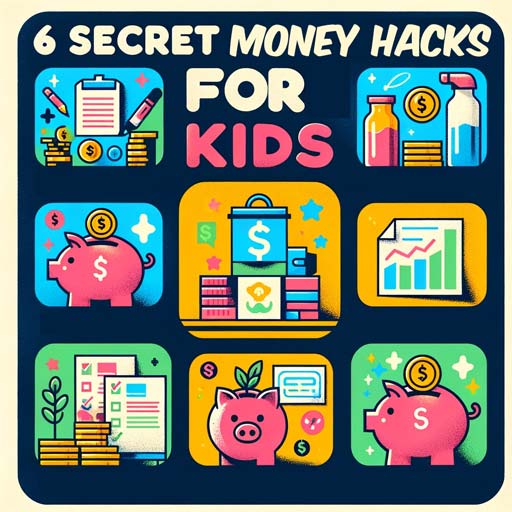What are the 6 secret money hacks?
These are six money habits I've been teaching my two boys, who are five and seven. And now they're very money savvy because these tips have been secretly learned from my very rich clients. As a mortgage broker with 15 years experience, I've gathered all their secrets, passed it down to my kids, and now I'm sharing them with you. Now, these six money habits, my rich clients do not want me to share them with you, the poor, poor folks, because they want to keep the status quo and they do not want your kids to be rich. Now, before I pass these six tips on to you and bestow them onto you so you can break the first generational chain of poverty in your family, I want you to accept you need to start giving your kids an allowance.
That's correct. If your kids are between five and ten, you need to start giving your kids money as an allowance, and I'll show you how. So, the foundation, before I give you the six tips, is that you need to start giving your kids a weekly allowance. For example, I give my kids $8 a week weekly allowance. And you need to specify a specific day.
For example, for me, every Monday, dad will give you $8 per week. It first begins with the number one tip or the number one rule of these six money habits. It's, for example, you got to be very clear when you're given the $8 or whatever money you want to give them. I suggest $8. To begin with, you set the clear rules, which is if you spend this money all before next Monday.
For example, I said every Monday. Well, the next few days. For example, if they spent it in two days, then the next five days, then there's no money. And for me, no excuse, no mercy. If you spent it all, you then need to live with the consequences.
And then after I set the rules, I set the goal of what I'm trying to teach you kids, even though they're five and seven, they still understand is self-discipline and also patience. Let me interject here before I go to tip number two is you got to let the kids spend whatever they want. For example, my kids like to spend on lollies or ice blocks at canteen. Let them do it. Don't control.
You want them to go and spend and realize the mistake that when they spend too much, there is no money to be given to them to buy further lollies and ice blocks. And that leads to money. Hack number two that I'll introduce my kids is that they can certainly ask for an advance. For example, they obviously ten times when they begin to get an allowance. They spent all their money, but they have the opportunity to ask for an advance, which is within the cap limit of what I give them.
For example, $8. They can ask for an advance of extra $8. But kids. But next week, I will deduct $2 interest off you. For example, you don't have $16.
Next week you only have $14. And the very valuable lesson to be learned by my kids here is that if they borrow money in advance, which is the term of a loan, to get it in advance, they lose $2 of interest. So before they borrow, they need to think, do I really need this money, or can I just wait? And leading to hack number three is what I tell my kids with the $8 they have, I encourage them to put them in four jars, which I'll give to them, which is a spend jar, save jar, invest jar, and give Jar, which obviously inspired me to write this kids finance book, Nana the Naughty Savings Jar, which is coming up very soon. Now, back from the commercial break.
These four jars, for example, $2 is for spending, $2 is for saving, $2 is for investing, and $2 is for giving. And let me digress. Now, the first jar, very simple. $2 a week you get to spend. Next is $2 to save.
Now, to encourage them to save every week, if they save $2, I'll give them fifty cents of interest, not $50.50. And at that moment, when I tell my kids, they're like, ooh, extra fifty cents per week, they don't understand the concept. But as I give them $0.50, as they save $2 or even more money. Wow. They're like, dad, I like saving.
The other $2 jar. When they put money in that $2 jar is they're investing in my business. For example, my 15 years mortgage or brokerage business, and now my new business, which is the kids finance author shop, for example, they spend $2 for the supplies of making this book a reality, obviously, cost of making this book. For every dollar that invests, I give them back $2. Yeah, that's how I treat my investors, but that is based on my net profit.
For example, my turnover, which is the sales of you guys buying the book eventually and then minus the expenses, which is the cost of printing the book. And in the final profit, based on how much I have, I'll give them two times of whatever they've invested in. Now, for my engineering and accounting, parents, don't get too overly worked up on how this works. As long as there is some form of profit in some sort of side business you're doing with them. Just give them the profit.
Very loose sense. For example, in total, in the year that they've been doing and playing this game with you, they've invested, for example, $50. Then give them about $300. It's just a concept you're planning to see. Oh, if I invest in a business, then I'll get a return.
That's the basic concept. Don't get so caught up in the bloody maths. The final jar is the gift jar. This is to give to charity. All right?
So at the end of the year, we go choose a charity they want to give in, and basically, whatever money they give, we double it. Then we show them the benefits of their giving. For example, kids having clothes to wear, homeless kids having shelter, and then basically saying, hey, you contributed to that. So basically, it gives them that endorphin feeling that giving and charity is good. Final hack number four, which we have some fun, well, kids, is to teach them entrepreneurial skills.
For example, the net profit they get from the investment jar, for example, they've got $300. We encourage them to use that profit to buy stocks, supplies, whatever things that the kids at school need, and try to make a profit. For example, my eldest child, who's seven years old, loves soccer. His friends also love soccer. They all love Messi.
So what we do with the profit is then we go and buy from, for example, Alibaba, or maybe sometimes from Etsy, like stickers, right? And then we try to make, or he tries to know pens and stationery that has Messi stickers on it, right? And then he tries to sell them to his friends. So far, it's a work in progress. We're still refining the R&D section of this little business that he has.
But the principle, the valuable principle that I'm trying to teach him is that once you have profit, don't just sit it in the save jar or go and spend it. Reinvest it into a business to try to make more money off it. And I'm sure your kid will say this to you, which my kid said this to me at a very early stage, is that, hey, dad, what if I don't make money? That's fine, as long as you try to start this project and go through with it, that will write off your loss and reimburse you so that you can try again. As for the other two hacks or the six hacks, I'm keeping that to myself.
Kidding - you can go here to download the quick outline 6 Secret Money Hacks for Kids here

